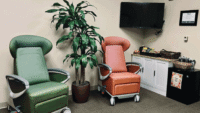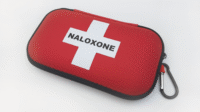Continuing Nursing Education
Learning objectives
1. Describe therapeutic hypothermia (TH).
2. Compare cooling methods used for TH.
3. Discuss clinical management of patients receiving TH.
Purpose/goal: To provide nurses with information on how they can best care for patients receiving therapeutic hypothermia. The authors and planners of this CNE activity have disclosed no relevant financial relationships with any commercial companies pertaining to this activity. See the end of this article to learn how to earn 1.4 CNE credit. Expiration: 6/1/20
Dr. Mary Smith*, age 56, is the picture of health—a vegetarian and an avid runner who logs about 50 to 60 miles each week. She’s also an accomplished researcher, traveling the country to present her findings.
One morning at home she has a seizure. She and her husband, a cardiologist, decide to go to the hospital to have her checked out. On the way there, Mary goes into cardiac arrest. Her husband calls 911 and begins cardiopulmonary resuscitation (CPR) at the roadside. In about 20 minutes, the ambulance arrives. When the emergency medical technicians deliver two shocks with the defibrillator, Mary regains spontaneous circulation. When she arrives at the hospital, she’s still unresponsive, so her husband and the emergency department physicians decide to begin therapeutic hypothermia (TH).
According to the American Heart Association (AHA), nearly 383,000 out-of-hospital sudden cardiac arrests occur each year. Neurologic injury is the most common cause of death after these events. Recent recommendations by the AHA and the International Liaison Committee on Resuscitation (ILCOR) recommend inducing mild hypothermia (32° to 34°C [89.6° to 93.2° F]) for 12 to 24 hours after out-of-hospital cardiac arrests followed by return of spontaneous circulation (ROSC) in adults who are unresponsive on admission. The goal of TH is to improve survival and neurologic function.
This treatment should begin within 6 hours of ROSC. Studies show the sooner it starts, the greater the benefit.
Renewed interest and unanswered questions
In 2002, clinicians took a new look at TH after two trials showed it brought significant improvements in neurologic function and survival. But much remains unknown about this therapy. For instance:
- What’s the best cooling method?
- What’s the optimal cooling temperature?
- How long should optimal temperature be maintained?
- How soon should patients be brought to target temperature after achieving ROSC?
- Can TH help other patients, such as those who’ve had in-hospital arrests and those who are conscious but not at their baseline neurologic status after ROSC?
A recent study found mild cooling (36° C [96.8° F]) is as effective as deeper cooling (33°C (91.4° F]) in achieving a good outcome. The use of mild cooling is currently under debate and has led some hospitals to use targeted temperature management (36° c [96.8° f]) in place of TH.
Despite the unanswered questions, bedside nurses have seen TH bring amazing recoveries. And although we may not be sure why it works, we’re convinced it’s making a difference.
How cooling affects the brain
After cardiac arrest, neurologic injury may manifest as coma and a decreased state of arousal, seizures, neurocognitive dysfunction, and brain death. Brain injury occurs during cardiac arrest and continues even as blood flow is reestablished. This response stems from multiple complex processes, such as inflammation and posthypoxic release of toxic substances that interfere with normal cell function. Cooling the brain decreases cellular metabolism by 5% to 7% for every 1° C drop in body temperature. Early and aggressive implementation of therapeutic hypothermia has been shown to protect against temperature-dependent mechanisms, such as fever.
Patient selection
All patients who remain unresponsive after cardiac arrest should be evaluated to determine if they’re good candidates for TH. Original trials excluded pregnant women and hemodynamically unstable patients. But since then, positive outcomes in these patients have been reported. The only absolute contraindications to TH are active noncompressible bleeding and do-not-resuscitate orders.
Cooling methods
Typical hospital protocols for TH call for multiple simultaneous interventions to achieve target temperature. Each intervention has advantages and disadvantages.
Cooling can be accomplished with noninvasive or invasive methods, or a combination. Clinicians should use the method that’s most readily available and familiar to them.
Noninvasive cooling methods
Noninvasive methods include the use of ice packs, fans, alcohol or cool-water baths, and cooling blankets not connected to a thermostatically controlled device. These low-cost, readily available methods have proven to be extremely effective in decreasing body temperature. On the other hand, they are labor-intensive, may not reduce core temperature rapidly enough, may not maintain target temperature, and may cause overcooling or lead to too-rapid rewarming. Technologies used in TH continue to advance, helping to reduce labor intensity for nurses, decrease patient risk, and speed the time to target temperature.
Initially, some clinicians may choose to give up to 30 mL/kg or 2 L of cold (4°C [39.2 °F) isotonic saline solution I.V. over 30 minutes to help drop the core temperature quickly. But recent evidence suggests this increases pulmonary edema and may cause negative hemodynamic effects, so it should be used cautiously on a case-by-case basis.
Thermostatically controlled devices. Although cooling can be initiated with ice packs and fans, it’s best to use a thermostatically controlled device to provide the most precise minute-to-minute temperature regulation. While expensive, these devices prevent excessive hypothermia and temperature fluctuations, which can harm the patient. Also, they can be used to promote controlled rewarming.
Noninvasive water-circulating systems, which use water-filled blankets or pads and hydrogel-coated pads, are placed on the patient’s skin. Along with a patient temperature source, the blankets or pads are connected to a console that automatically adjusts circulating water temperature to achieve and maintain target temperature. A water-circulating system can be started immediately with a nurse-driven protocol, with no need for direct physician intervention. Be aware that it may cause skin injury with prolonged and intense surface cooling, although this risk appears low and can be reduced with frequent skin assessments and monitoring of water temperature.
Invasive cooling methods
Endovascular cooling systems use a specialized heat-exchange catheter that’s inserted into a central vein and connected to an external temperature-control module. Cold water circulates through a balloon on the catheter tip to cool the patient. A sensor provides feedback on the patient’s temperature and makes adjustments to maintain the programmed target temperature. With this system, the catheter can be used for central venous access, allowing medication administration, central venous pressure monitoring, and blood sampling.
As a major disadvantage, it requires a specially trained practitioner to place the catheter, which may delay initiation of cooling. Also, it carries the risk of catheter-related injury and infection, although this risk appears similar to that of other central catheters. (See PDF link: Comparing invasive and noninvasive cooling methods.)
Patient monitoring
Regardless of the cooling method used, accurate temperature monitoring throughout TH is crucial. The patient’s core temperature must be monitored closely via an esophageal, bladder, or pulmonary artery catheter (PAC) or a rectal temperature probe. For optimal safety, two monitoring methods should be used. Although PACs are the gold standard for core temperature monitoring, most patients don’t require one.
Monitor patients with a temperature-sensing Foley catheter for adequate urine output to ensure accurate readings. When positioned correctly, esophageal probes rapidly and accurately detect temperature changes. Rectal probes are easy to insert but are more likely to become dislodged; also, they have a longer lag time in detecting temperature changes.
Hypothermia induces physiologic changes in virtually every organ, so vigilant monitoring is required to keep the patient safe. Initially, you may note an increase in the patient’s heart rate, but as the patient cools, bradycardia commonly occurs. Due to the decreased metabolic demand during TH, bradycardia rarely requires intervention as long as blood pressure is stable.
Patients may become hypotensive from sedation or loss of cardiac function, which might warrant volume replacement or vasopressors. In addition, cold diuresis may occur, possibly leading to hypovolemia and electrolyte loss. Be sure to monitor laboratory results, especially electrolyte levels. During TH, potassium, magnesium, and phosphate shift into the intracellular space, resulting in low levels. As needed and ordered, replace electrolytes and stay alert for arrhythmias. Know that metabolic effects of cooling may alter arterial blood gases, causing increased PaO2, decreased CO2, and acidosis. These reactions can be controlled primarily with ventilator setting changes.
Hyperglycemia is common during TH and linked to poor outcomes in critically ill patients. During cooling, insulin sensitivity decreases, so patients may need high insulin doses to keep blood glucose levels within the range of 140 to 180 mg/dL. Also, gut motility decreases, so enteral feedings may be needed once the patient is rewarmed. TH decreases liver metabolism of drugs; thus, boluses are recommended instead of continuous infusions or short-acting agents when possible.
Infection and bleeding risk
TH may lead to infection and bleeding. Hypothermia impairs leukocyte function, which may increase the risk of infection (especially in wounds) and pneumonia. Keep in mind that hypothermia masks an increased body temperature—a key sign of infection. Also, body temperatures below 35° C (95° F) depress clotting enzyme reactions and impair platelet function. Mild coagulopathy may increase bleeding risk in some patients, although this risk is comparable to that in patients who remain normothermic after cardiac arrest.
Three phases of TH
TH occurs in three phases—cooling (induction), maintenance, and rewarming. (See the box below.)
Phases of therapeutic hypothermiaInduction: unstable period during which the patient’s core temperature is reduced quickly to target temperature Maintenance: more stable period during which the patient is maintained at target temperature for 12 to 24 hours Rewarming: relatively unstable period during which the patient is returned to normothermia over the course of 12 to16 hours |
Induction phase
The induction phase usually is the most unstable period, so clinicians should try to get patients through it as quickly as possible. Once core temperature drops to approximately 33.5° C (92.3° F), patients typically become more stable. Most evidence suggests target temperature should be achieved within 6 hours of ROSC. Before therapy begins, all patients must be intubated and mechanically ventilated and an indwelling urinary catheter, adequate venous access, and two core temperature-sensing devices must be placed.
Shivering is a major complication of TH. Vasoconstriction and shivering are normal thermoregulatory responses to cooling as the body attempts to maintain normothermia. Shivering typically raises the basal metabolic rate two to five times the normal rate. Linked to increased heat production, oxygen consumption, and CO2 production, shivering impedes the ability to cool the patient and may negate the possible neuroprotective effects of TH. (See the PDF link: The dangers of shivering during TH .)
All patients undergoing TH should receive sedation to decrease metabolic demand, oxygen consumption, and the shivering threshold as well as to help maintain neuroprotective benefits of TH. The most commonly used sedatives are propofol, midazolam, and dexmedetomidine. Continuous propofol and fentanyl infusions are highly effective during TH. Also, propofol has antiseizure properties at high doses. Some clinicians may start with propofol, increase the dosage, and add fentanyl if needed. Be aware that propofol has no analgesic effects, so if you think your patient on propofol is in pain, start fentanyl as ordered. Hypotensive patients may require midazolam instead of propofol; be aware, though, that midazolam accumulation may complicate subsequent neurologic examination because it can take days to clear the body.
Meperidine is one of the most beneficial agents in reducing the shivering threshold. However, some clinicians are reluctant to use it because of its proconvulsant effects in an already vulnerable patient population. Buspirone helps prevent shivering but is available only in oral form, takes 1 hour to reach peak plasma concentrations, and depends on a functioning gut for absorption. Magnesium sulfate may promote the cooling process through its effects on peripheral vasodilation and thus decrease the time to target temperature. With low magnesium levels linked to an increased shivering risk, maintaining magnesium levels of 2.5 to 3.5mg/dL appears to be a reasonable goal.
Inducing paralysis with neuromuscular blocking agents (NMBAs) is highly effective at suppressing shivering. But remember that although the muscles stop moving, the brain is still working and trying to generate a shivering response. This makes sedation crucial. NMBAs are the quickest way to stop shivering and don’t cause hypotension. But they mask seizures, which have been reported in more than one-third of post-cardiac arrest patients. So patients receiving paralytic agents should undergo continuous electroencephalographic (EEG) monitoring to detect seizures. Once target temperature is achieved, paralytic drugs usually can be withdrawn during the maintenance phase, as most patients can’t mount a shivering response at that point. NMBAs may need to be restarted during rewarming as the patient passes through the shivering threshold again. (See PDF link: Drugs used in therapeutic hypothermia.)
Maintenance phase
Once target temperature is achieved, it needs to be maintained for a certain period—typically 12 to 24 hours. During this phase, monitor the patient’s vital signs, fluid status, and laboratory tests and intervene as needed. Provide supportive care to ensure skin integrity, especially if you’re using a water-circulating device on the skin’s surface. Also perform basic critical-care interventions, such as venous thromboembolism prophylaxis, measures to prevent ventilator-associated pneumonia, and eye care for patients receiving paralytics.
Rewarming phase
Rewarming must be done in a slow, controlled manner. Rapid rewarming can cause electrolyte abnormalities, cerebral edema, seizures, and other problems that negate the benefits of TH. The patient’s temperature should be increased no more than 0.5° C per hour; many clinicians prefer 0.25° C per hour. It may take 12 to 16 hours to get the patient back to a temperature of about 36.5° C (97.7° F). Use of thermostatically controlled devices allows controlled temperature management through all hypothermia phases, especially rewarming.
As patients begin to rewarm, they pass through the shivering threshold again; as needed, reinstate interventions used previously to prevent shivering. Stop administering potassium-containing infusions several hours before rewarming starts; potassium shifts out of the cell during rewarming, putting the patient at risk for hyperkalemia. Glucose levels start to normalize, so monitor the patient’s glucose level closely and adjust the insulin drip as necessary.
Once the patient reaches a core temperature of 36° C (96.8° F), discontinue any paralytic agents that were restarted during rewarming. Start weaning the patient off sedatives so a complete neurologic evaluation can be completed.
Evidence suggests clinicians should prevent posthypothermia fever, which may be associated with increased mortality or worse neurologic outcomes. To do this, leave the cooling device in place for 24 to 36 hours after the patient has been rewarmed and maintain normothermia for the duration of the rewarming period.
Assessing neurologic status after TH
Evaluating the patient’s neurologic status after TH can be challenging. Drugs used for sedation and shivering suppression may make clinical assessment unreliable. Diagnostic tests used to evaluate the patient’s neurologic status may include magnetic resonance imaging, EEG, and somatosensory evoked potentials. AHA and ILCOR recommend delaying neurologic prognostication for at least 72 hours after the patient has been rewarmed. Signs of poor clinical prognosis include absent corneal, pupillary, and motor responses and extensor posturing after rewarming.
Keep in mind that TH can be a difficult time for the patient’s family as they wait to see if and how well their loved one will recover. You can play an important role in providing support, answering questions, and providing honest but sensitive communication about the patient’s condition.
Dr. Smith’s outcome
The team works hard to ensure they’re doing everything they can to implement and follow the hypothermia protocol, to provide the best chance for Mary Smith’s complete recovery. They know that just surviving this event won’t be enough for her; she loves her research and they are sure she’ll want to be able to continue it. The team initiates cooling per hospital protocol, using iced saline and water-circulating cooling pads to reach target temperature in 3.5 hours. When Kathleen experiences minor shivering, they administer fentanyl and propofol for sedation and to manage shivering. Her potassium levels remain below normal; the team monitors these levels closely and administers replacement potassium.
After being maintained at target temperature for 18 hours, they rewarm Mary over the next 16 hours. The day after she is rewarmed, she is extubated; she looks at her husband and calls him by name. Although her recovery takes some time, she eventually returns to her practice and has several articles published again in prominent medical journals.
Julie M. Waters is a clinical nurse educator for critical care at Providence Sacred Heart Medical Center in Spokane, Washington. Selected references
Arrich J, Holzer M, Herkner H, et al. Hypothermia for neuroprotection in adults after cardiopulmonary resuscitation. Cochrane Database Syst Rev. 2012;(4):CD004128.
Badjatia N, Strongilis E, Gordon E, et al. Metabolic impact of shivering during therapeutic temperature modulation: the Bedside Shivering Assessment Scale. Stroke. 2008;39(12):3242-7.
Bro-Jeppesen J, Hassager C, Wanscher M, et al. Post-hypothermia fever is associated with increased mortality after out-of-hospital cardiac arrest. Resuscitation. 2013;84(12):1734-40.
Hazinski MF, Nolan JP, Billi JE, et al. Part 1 Executive summary: 2010 International Consensus on Cardiopulmonary Resuscitation and Emergency Cardiovascular Care Science With Treatment Recommendations. Circulation. 2010;122(16 Suppl 2):S250-75.
Neumar RW, Nolan JP, Adrie, C, et al. ILCOR Consensus Statement: Post-Cardiac Arrest Syndrome. Epidemiology, Pathophysiology, Treatment, and Prognostication. A consensus statement from the International Liaison Committee on Resuscitation (American Heart Association, Australian and New Zealand Council on Resuscitation, European Resuscitation Council, Heart and Stroke Foundation of Canada, InterAmerican Heart Foundation, Resuscitation Council of Asia, and the Resuscitation Council of Southern Africa); the American Heart Association Emergency Cardiovascular Care Committee; the Council on Cardiovascular Surgery and Anesthesia; the Council on Cardiopulmonary, Perioperative, and Critical Care; the Council on Clinical Cardiology; and the Stroke Council. Circulation. 2008; 118(23):2452-83.
Nielsen N, Wetterslev J, Cronberg T, et al. Targeted temperature management at 33° C versus 36° C after cardiac arrest. N Engl J Med. 2013;369(23):2197-206
Olson DM, Grissom JL, Williamson RA, et al. Interrater reliability of the bedside shivering assessment scale. Am J Crit Care. 2013;22(1):70-4.
Polderman KH, Herold I. Therapeutic hypothermia and controlled normothermia in the intensive care unit: practical considerations, side effects, and cooling methods. Crit Care Med. 2009;37(3):1101-20.
Rittenberger JC, Callaway CW. Post cardiac arrest management in adults. UpToDate®. Last updated January 9, 2014. http://www.uptodate.com/contents/post-cardiac-arrest-management-in-adults?source=search_result&search=Post+cardiac+arrest+management+in+adults&selectedTitle=1%7E23. Accessed April 10, 2014.
*Name is fictitious.
CNE Instructions
To take the post-test for this article and earn contact hour credit, please click here. Simply use your Visa or MasterCard to pay the processing fee. (ANA members $15; nonmembers $20.) Once you’ve successfully passed the post-test and completed the evaluation form, you’ll be able to print out your certificate immediately.
Provider accreditation
The American Nurses Association’s Center for Continuing Education and Professional Development is accredited as a provider of continuing nursing education by the American Nurses Credentialing Center’s Commission on Accreditation. ANCC Provider Number 0023. Contact hours: 1.4 ANA’s Center for Continuing Education and Professional Development is approved by the California Board of Registered Nursing, Provider Number CEP6178 for 1.6 contact hours. Post-test passing score is 75%. Expiration: 6/1/20
ANA Center for Continuing Education and Professional Development’s accredited provider status refers only to CNE activities and does not imply that there is real or implied endorsement of any product, service, or company referred to in this activity nor of any company subsidizing costs related to the activity. The planners and author of this CNE activity have disclosed no relevant financial relationships with any commercial companies pertaining to this CNE.



















2 Comments.
My son at the age of 31 had a heart attack and and he was put into a hypothermic state. It was hard on the family but the outcome was miraculous. Though his kidneys didn’t like the process they recovered. Neurologically my son had some residual effect but overall he is back to his normal self. He now is back in school teaching and plays rugby. Hypothermia saved his personality and intelligence and all of his motor function.
I’d be interested to know what the research shows if TH is used on a patient with Raynaud’s syndrome or phenomenon.